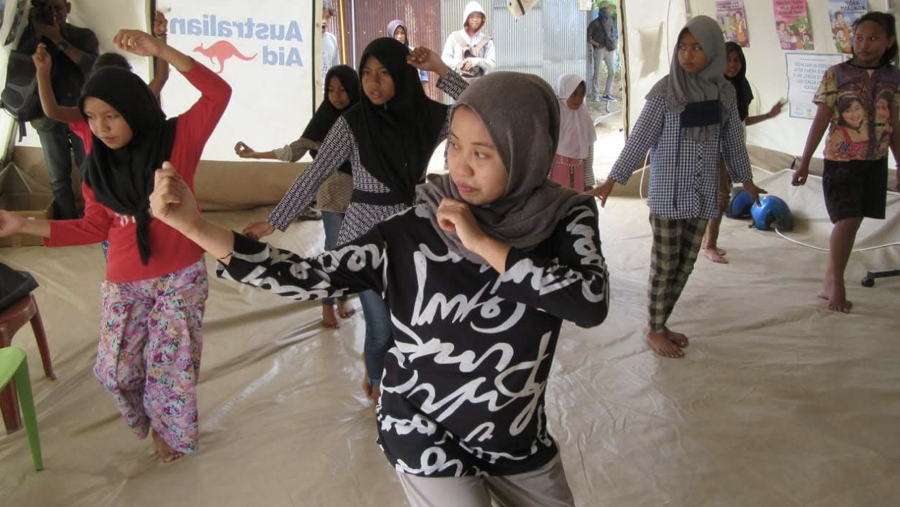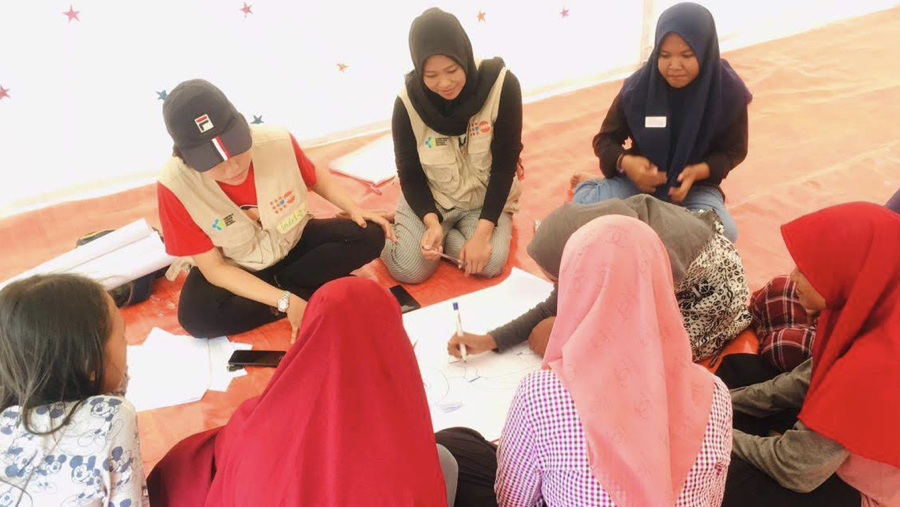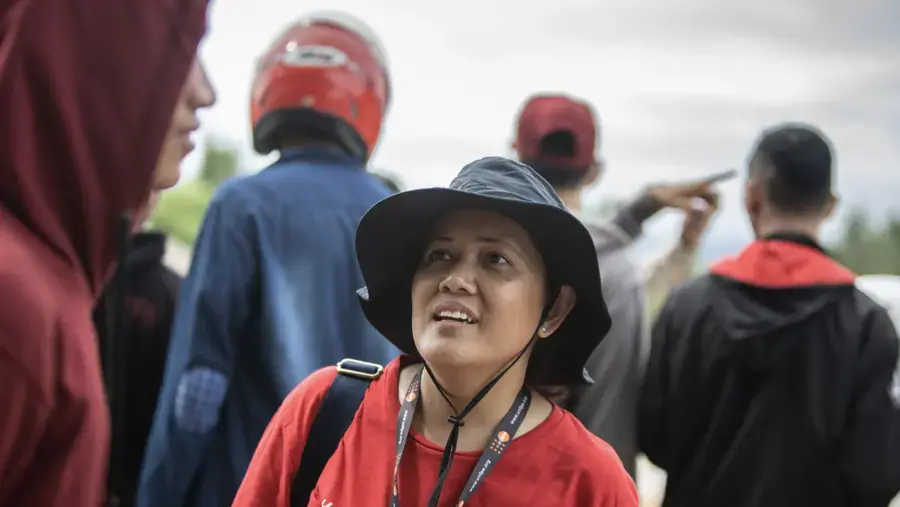Humanitarian Profile: Nur Arifina Vivinia
“Young people are some of the most impacted but they were not being considered in the response”
Nur Arifina Vivinia (Vivien) is a member of the Women's Global Network for Reproductive Rights. She works with UNFPA Indonesia by coordinating youth engagement in emergencies programmes in a country that is on the frontline of increasingly extreme climate disasters.
Vivien has been through more than a dozen disasters as a humanitarian worker. She says each one provides new opportunities to learn. “If you ensure young people’s voices are included in an emergency,” she says, “it improves inclusion during and after the recovery.”
“Young people's voices are powerful. By empowering young people who have information and access, the word will get out and they will spread out to their peer groups."
She says the most important thing is to provide flexible services and engage young people in designing services so that young people can access adolescent sexual and reproductive health (ASRH) services and information easily.
“Young people's voices are powerful," Vivien says. "By empowering young people who have information and access, the word will get out and they will spread out to their peer groups."
Her role is to facilitate better coordination between the national government and the district health offices, so there is a synchronized response in emergencies.
“Access to services and information is crucial for young people, Access is the first thing we look at when we do a field assessment.”
“Access to services and information is crucial for young people,” Vivien says. “Access is the first thing we look at when we do a field assessment.”
She says it’s less about creating a safe and friendly space, and more focused on providing a flexible operational times for services to support young people.
“You have to think about these spaces for young people, how they could get together and share information about sexual and reproductive health," she says. "One of the approaches taken is by carrying out activities based on their interests as well as having discussions on topics interesting to them. It happens naturally when they talk about movies, social media, but it needs to happen in safe and friendly places where they can access information and services at the same time.”

Vivien says that when she first started working in disasters, information about young people affected by disasters was very limited.
“I went to one of the camps there and then I asked about the number of the young people,” she says. “They didn’t haveany data regarding the young people, and if there is any data it’s limited to women and young children only. It regularly happens during emergencies. ”
"Young people have unique vulnerabilities as well as resilience during emergencies."
Vivien says it was shocking to find the lack of services for young people during emergency situations. “Young people are some of the most impacted but they were not being considered in the response,” she says. “They also have unique vulnerabilities as well as resilience during emergencies."
She played a key role in helping Indonesia build a youth engagement network to help shape the response. “We’re trying to develop program approaches through peer support mechanisms such as peer educators,” she says.
Vivien says the peer-to-peer approach immediately helps young people open up about the issues they are facing and creates referrals for them to access services from nurses and doctors.
“We create safe places for young people to access ASRH information services, psychosocial support and youth engagement activities at youth friendly spaces,” she says. “This helps young people feel at ease as a part of psychosocial support in crisis situations.”
“We create safe places for young people to access ASRH information services, psychosocial support and youth engagement activities at youth friendly spaces.”
She says she’s seen girls go from shy and less confident to becoming youth leaders in their community because of the peer-to-peer program. The youth programs boosts youth confidence and skills to support their peers and communities.“There was a girl and she was crying,” Vivien remembers. “She could not say anything. After being involved in the program for a few months, this young girl could speak up and became a dedicated youth leader.”
Vivien says it’s important to gain trust and create an open discussion about Adolescent Sexual Reproductive Health issues with young people. She says dignity kits are one of the tools that could be used to have an open and broader discussion about ASRH between young people and midwives. “First we have the first medical supplies,” she says. “A midwife takes them and she has a way to start a discussion with young women.”
Vivien says there is information on adolescence, sexuality and healthy young people and the materials help humanitarian teams communicate with young people.
Vivien says building a cluster of youth and women friendly spaces near the Sexual and Reproductive Health clinic allows for the integrated services to be accessed in an easier and more discreet way.
“The interface revolves around the health post,” she says. “But there is a women-friendly space as well as the youth forums.”
Vivien says that once young people are invited into the discussion about what supplies they need in a crisis situation, all kinds of helpful suggestions about the contents of the kits are made.
“We have consultations with the young people through Youth Friendly Spaces with the Youth Forum,” she says. “Based on the consultation with the young people, they share ideas. For example the underwear needed to be adapted to young people so that it fits them.”

In addition to including the youth perspectives, Vivien says it is equally important to adapt the response with localized languages and engagement with community leaders.
“We are trying to use localized languages,” Vivien says. “There's local people, and the youth also engage with the community leaders or camp leaders. It’s really important that you plan on this as a separate engagement and plan time to inform them about the projects.”
While coordinating in a humanitarian response is critical, Vivian says it’s also important to build systems so young people can be involved in planning. Her advice to colleagues: “Be sure your project caters to the participation of the young people in the preparedness stage. This makes it easier for us to engage local organizations who are working there.”
Vivien says despite the progress that has been made in preparedness, there are still gaps in the system, especially for women, girls, and boys. “During the emergency, there is a basic need that is not being fulfilled,” she says.
Vivien says that the breakdown of social structures leaves some girls and boys without knowledge of the basics of their body. “Some girls said don't know what menstruation even is,” she says. “They just feel that bleeding, but they don't know that menstruation is a natural part of puberty.”
These experiences have motivated her to push for girls to have a seat at the planning discussion, but mostly by creating a space for young people to have discussions amongst themselves about the issues they are most concerned about.
“When I see girls that don’t know about basics like mentrural hygiene, you realize that the needs are enormous."
“When I see girls that don’t know about basics like menstrual hygiene, you realize that the needs are enormous," she says. "At least we can help the discussion take place at Youth Friendly Spaces.”
Vivien says that creating a safe space for young people has also created pathways for girls to report cases of gender-based violence. Despite the progress in creating reporting mechanisms, she says there are many cases of abuse and even teen pregnancy where the girls are afraid to talk about it.

“Most young people are afraid or don't want to report,” she says. “Even though they could lead to unintended pregnancies sometimes."
Vivien says the girls will talk about their symptoms so it’s up to the health workers to spot some of the signs. “Girls will say ‘I just got headaches for so many days, and I think I'm not feeling well.’ They don't even know about pregnancy,” she says.
Having this close relationship with peer leaders, nurses and health workers then allows girls to talk more openly.
“In humanitarian settings, girls are more vulnerable to violence, often there is abuse in their pain.”
“In humanitarian settings, girls are more vulnerable to violence, often there is abuse in their pain,” Viven says. “If they are not aware of certain kinds of abuse we support and educate them such as by providing comprehensive sexuality education and psychosocial support through. Youth-Friendly Spaces, Women Friendly Spaces and reproductive health tents as integrated services in crisis situations.”
Vivien says all these services need to work together to listen to young people and deliver the services they need and ask for. Through integrated services in crisis situations, UNFPA and its partners have succeeded in creating a safe place for young people to access information and services as well as having their voice heard and needs met in crisis situations.
Learn more
Minimum Standards for Prevention and Response to Gender-based Violence in Emergencies


